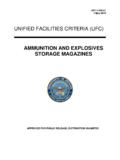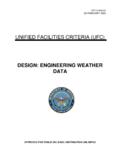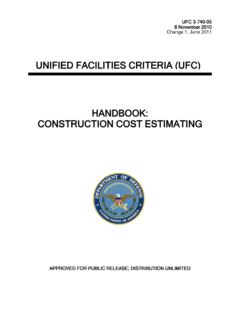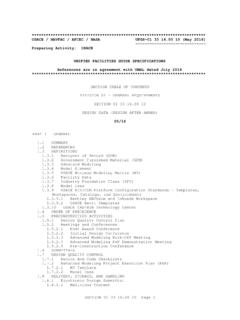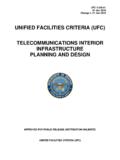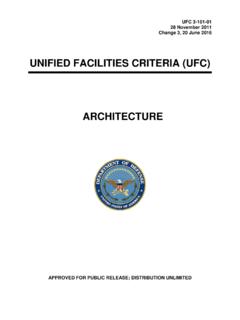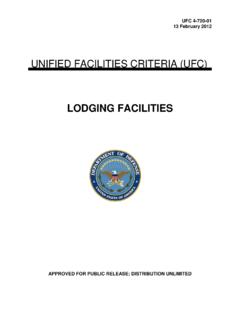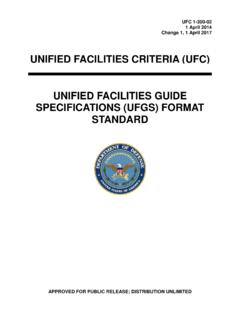Transcription of HANDBOOK for SELF-ASSESSING SECURITY …
1 HANDBOOK for SELF-ASSESSING SECURITY vulnerabilities & risks of INDUSTRIAL CONTROL SYSTEMS on DOD INSTALLATIONS 19 December 2012i This HANDBOOK is a result of a collaborative effort between the Joint Threat Assessment and Negation for Installation Infrastructure Control Systems (JTANIICS) Quick Reaction Test (QRT) and the Joint Test and Evaluation (JT&E) Program under the Director, Operational Test and Evaluation, Office of the Secretary of Defense. The JT&E Program seeks nominations from Services, combatant commands, and national agencies for projects that develop test products to resolve joint operational problems. The objective of the JT&E Program is to find ways for warfighters to improve mission performance with current equipment, organizations, and doctrine.
2 Please visit for additional information on the JT&E Program. HANDBOOK content is a result of the combined work of the 346th Test Squadron, 262d Network Warfare Squadron, and the Idaho National Laboratory under the aegis of the Air Force Joint Test Program Office with advice of Joint Warfighter Advisory Group (JWAG) members/stakeholders. Myriad of other agencies influenced content by means of their publications (sources listed in an appendix). ii Contents EXECUTIVE SUMMARY .. 1 INDUSTRIAL CONTROL SYSTEMS 101 .. 5 HANDBOOK AUTHORITIES .. 8 DISTINCTIONS BETWEEN ICS AND IT .. 8 THREATS .. 10 MISSION PRIORITIES .. 11 MISSION IMPACT .. 15 THE MOST SECURE ICS .. 16 RISK ASSESSMENT & MANAGEMENT .. 19 FRAMEWORK FOR SUCCESSFUL ICS DEFENSE .. 19 ICS SECURITY ASSESSMENT PROCESS.
3 21 SOFTWARE TOOLS .. 25 ADDITIONAL RESOURCES .. 26 ICS SECURITY ACTIONS .. 26 RECOMMENDED ICS DEFENSE ACTIONS .. 27 POLICY .. 27 LEADERSHIP .. 28 PERSONNEL .. 29 TRAINING .. 30 ORGANIZATION .. 31 FACILITIES .. 32 MATERIEL .. 32 CYBER SECURITY .. 34 APPENDIX A REFERENCES .. 37 APPENDIX B WEB LINKS .. 42 APPENDIX C ACRONYMS .. 44 APPENDIX D GLOSSARY .. 48 APPENDIX E CE BRIEFING GRAPHICS .. 55 APPENDIX F RISK ASSESSMENT & MANAGEMENT MODELS .. 56 APPENDIX G CSET .. 60 APPENDIX H DCIP .. 62 APPENDIX I UNIVERSAL JOINT TASKS .. 63 iii APPENDIX J ICS TRAINING OPPORTUNITIES .. 65 APPENDIX K ICS SECURITY ORGANIZATIONS .. 69 ATTACHMENT 1 MAPPING INTERDEPENDENCIES & assessing RISK .. 71 ATTACHMENT 2 CHECKLIST OF RECOMMENDED ACTIONS .. 84 ATTACHMENT 3 COMMITTEE ON NATIONAL SECURITY SYSTEMS INSTRUCTION 1253 ICS OVERLAY VERSION 1.
4 105 ATTACHMENT 4 CSET INSTALLATION ICS ENCLAVE EXAMPLE .. 200 Figures 1. ICS SECURITY Assessment Eight-Step Process p. 3 2. PLCs & RTUs: The Challenge of Finding the Connectivity p. 6 3. Mapping Mission Assurance to ICS p. 12 4. The ICS SECURITY Team p. 19 5. It Only Takes a Minute p. 34 With mission assurance utmost in mind, this HANDBOOK is intended to provide an installation commander & staff with a generalized approach to eliminate, minimize, or otherwise mitigate risks to the mission as posed by Industrial Control System (ICS) vulnerabilities . The most common cause of task degradation or mission failure is human error, specifically the inability to consistently manage risk. OPNAVINST (2010), para. 4 1 Industrial Control Systems Vulnerability & Risk self -Assessment Aid EXECUTIVE SUMMARY Key Points The primary goal is mission assurance.
5 The primary focus is on risk management. The primary audience is the installation commander, with his or her staff as close secondary. The primary intent is to facilitate self -assessment of Industrial Control Systems (ICS) SECURITY posture vis- -vis missions priorities. The primary approach is generic, enabling broad (Joint/all Services) utility. One of the essential responsibilities of the installation commander and supporting staff is to manage risks to establish optimal conditions for assuring successful accomplishment of assigned missions every day. Although not always obvious, many missions depend on the unfailing functioning of ICS and therefore on the SECURITY of those systems. A mission assured today is never taken for granted as assured tomorrow. Mission assurance demands constant vigilance along with proactive risk management. risks come in myriad shapes and sizes some enduring, some sporadic and situational, others appearing without warning.
6 ICS represent only one set among a vast array of mission vulnerabilities and risks , an array that often competes for resources and, therefore, requires prioritization of management actions. This HANDBOOK is intended for use primarily by Department of Defense (DOD) installation commanders, supported by staff members, as a management tool to self -assess,1 prioritize, and manage mission-related vulnerabilities and risks that may be exposed or created by connectivity to ICS. ICS include a variety of systems or mechanisms used to monitor and/or operate critical infrastructure elements, such as electricity, water, natural gas, fuels, entry and access (doors, buildings, gates), heating & air-conditioning, runway lighting, etc. Other terms 1 Other entities and programs are available to conduct formal and very thorough technical assessments, but those must be coordinated, scheduled, and resourced ( , funded).
7 This aid provides an ability to conduct self -assessments when/as necessary or desired, and thereby, also the ability to prioritize and manage the resources required to address identified vulnerabilities and risks . 2 often heard include SCADA, DCS, or Throughout this book the term ICS is used as encompassing such variations. This book is intentionally generic. Whatever the category of ICS, the approach to vulnerability assessment and risk management is similar. The applicability of actions recommended here may be extended to any DOD military installation regardless of the specific categories of ICS encountered. In keeping with the generic approach and due primarily to the unique nature of each installation s infrastructure, beyond a couple of exceptions there are no checklists, standard operating procedures (SOP), or similar sets of lock-step actions provided here.
8 However, a risk management team using the HANDBOOK likely will want to develop checklists tailored to their specific circumstances. Among other purposes, this HANDBOOK is intended to increase awareness of how a threat related to the ICS itself translates into a threat to the mission, either directly through the ICS or circuitously via network connections. Every military installation has numerous mission-support processes and systems controlled by, or that otherwise depend on, ICS. Every connection or access point represents potential vulnerabilities and, therefore, risks to the system under control ( , electrical, water, emergency services, etc.), which can escalate quickly to adverse impact on mission essential functions (MEF) and mission accomplishment. Fundamentally then, this HANDBOOK is provided to help the installation leadership conduct a risk self -assessment focused on ICS and supported missions and then implement plans to manage that risk.
9 Most of the information contained herein is not unique to this publication. Two unique aspects are: (1) the aggregation of disparate information into one place, distilling essentials, and tailoring to DOD installation leadership; and (2) bringing cyber/information technology (IT), civil engineers, public works, and mission operators together with a singular focus on ICS SECURITY in support of missions. This HANDBOOK (via Appendices) also points to additional resources. The key set of activities one exception to the no checklists approach is found under the heading ICS SECURITY Assessment Process. Succinctly the process consists of eight steps, which if implemented with deliberation and in a team environment, will set the success conditions for all other actions recommended or suggested within this HANDBOOK (see Figure 1). This set of eight steps represents the core of the HANDBOOK .
10 All other information herein is intended to support implementation of those eight steps. 2 SCADA= Supervisory Control and Data Acquisition; DCS = Distributed Control System; EMCS = Energy Management Control System. Other variations exist; for example, building control systems. 3 Before explaining the eight-step assessment process, the HANDBOOK provides introductory, informative and supporting information. Closely aligned with and serving as companion to the Assessment Process is a section titled Framework for Successful ICS Defense. If the installation does not already have a single ICS manager and/or team, the Framework should be considered prior to engaging on the eight-step process. 4 Figure 1. ICS SECURITY Assessment Eight-Step Process 5 INDUSTRIAL CONTROL SYSTEMS 101 Key Point Understanding ICS is not difficult; the challenge is to understand the ICS relationship to missions.
